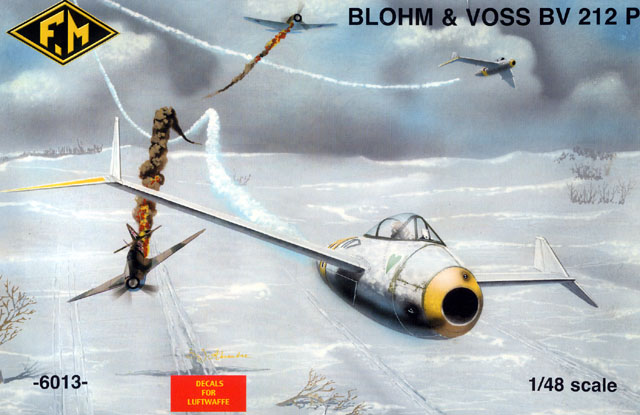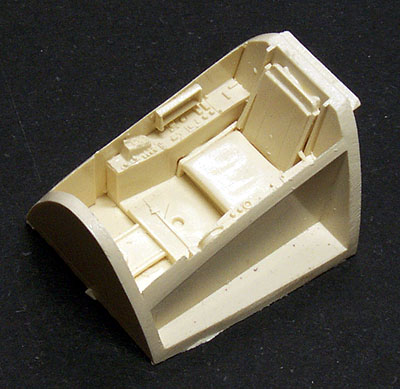|
Blohm
& Voss 212 P.03

Fonderie Miniatures

Fonderie
Miniature's 1/48 scale Blohm & Voss 212 P03
is available
online at Squadron.com
S
u m m a r y
|
| Catalogue Number: |
Stock No. FN6013 |
| Scale: |
1/48 scale |
| Contents and Media: |
40 limited-run injection plastic parts;
16 white metal parts; 1 resin part; 2 vacform |
| Price: |
USD$33.96 from
Squadron.com |
| Review Type: |
First Look |
| Advantages: |
Effective use of multi-media; nicely
detailed resin cockpit; robust and detailed white-metal landing gear;
spare vacform canopy supplied; boxed-in wheel wells, intake and jet pipe
- no "see-through" effect. |
| Disadvantages: |
Modelling skills required: rough surface texture on plastic parts; butt-join for wings to fuselage;
trimming required for correct anhedral of outer stabilizer surfaces |
| Recommendation: |
Recommended to experienced modellers
who are fans of Luftwaffe '46 subjects. |
Reviewed by
Brett Green
Modellers who build "Luftwafe '46" project aircraft
are certainly well catered for today. With AmTech's
1/48 scale Ta 183 due for release this month, Planet Models recent Focke-Wulf
Triebflugel, Huma's lovely 1/72 scale Ju 288
and more, "Luft '46" modellers have never had it so good!
Added to this growing list is Fonderie Miniature's 1/48
scale Blohm & Voss BV 212 P.03.
The BV 212 was a project aircraft
designed to use the powerful yet compact HeS 011 jet engine. This
design was in competition with the Ta 183 for a new high-altitude fighter.
Although the Ta 183 eventually won the right to full production, the
tailless BV 212 design was extensively tested and limited orders were
placed. Construction of the BV 212 commenced in May 1945, but was cut
short by the end of the war in Europe before any aircraft were completed.
For more information about the Blohm & Voss BV 212,
see Dan Johnson's "Luftwaffe
'46" site.
Fonderie Miniature's BV 212 P.03 is a limited-run,
multi-media kit. The kit comprises 40 low-pressure injection moulded
parts, a single resin part and 16 pieces in white metal. The canopy is
provided as a vacform part, and a spare is supplied. Markings for two
schemes are also included.
The bulk of the kit is styrene. The plastic parts feature
consistent engraved detail, but most of the parts display an
orange-peel texture. Ragged flash is also present on most parts. Sanding and polishing
will be required. The wing
trailing edges are a little thick and will benefit from thinning before
the halves are joined. Wheel wells are detailed with structural
features. Ejector pin marks are present inside
the wheel well cavity so they will be almost invisible without the aid of a mirror and
flashlight!
Click the thumbnails below
to view larger images:
The fuselage interior includes alignment marks for the
cockpit, but reinforcement of major joins is left to the modeller. The big
wings with their outrigger stabilizers are simply butt-joined to the
fuselage sides. These critical joins will certainly need reinforcement
with metal rod or wire to ensure a permanent bond. The instructions also
note that the outside of the wing will have to be trimmed to achieve the
correct anhedral for the stabilizers. This will be a tricky exercise. The
safest approach might be to build a temporary jig to hold the fuselage and
wings, and to set the angle for the outrigger stabilizers.
 The cockpit tub, side consoles and seat are supplied as a
single resin part. This is a very nice casting with switch detail and a
convincing texture for the seat cushion, although the harness is not
depicted. Plastic parts are added for the instrument panel, rudder and
control column. The cockpit tub, side consoles and seat are supplied as a
single resin part. This is a very nice casting with switch detail and a
convincing texture for the seat cushion, although the harness is not
depicted. Plastic parts are added for the instrument panel, rudder and
control column.
The undercarriage is supplied in white metal. This media
will ensure maximum strength plus a measure of adjustment after the legs
are secured to the fuselage. The white metal parts are nicely detailed -
they should look great after the customary clean-up. A robust
undercarriage will be a big advantage because it looks to me as if plenty
of nose-weight will be required to prevent this model being a tail-sitter!
The canopy is supplied as a vacform part. This is quite
thin and clear. A spare is provided in case of mishaps while the canopy is
being removed from its backing.
Instructions are supplied on two double-sided sheets of A4
paper using exploded view drawings. These drawings are generally adequate
for this simple model. Additional placement diagrams are provided for the
main gear and nose gear to clarify the correct angle from the forward and
side views. Painting suggestions are also supplied on these pages, but one
of the joys of a kit such as this is that the imagination can run wild
with hypothetical paint schemes.
Modelling skills are definitely required to
build Fonderie Miniature's 1/48 scale Blohm & Voss BV 212 P.03. In
particular, prior experience will be necessary to adequately clean up the
plastic parts, reinforce the major joins and achieve perfect alignment of the
complex wing and stabilizer dihedral/anhedral angles.
Patience, planning and plenty of test-fitting will be the best
formula for approaching this model.
However, Fonderie Miniature has supplied all the parts to
produce an interesting and adequately detailed BV 212 P.03. If you are a fan of Luft '46 aircraft, and have some experience
with limited-run multi-media kits, this FM's 1/48 scale BV 212 is
certainly worth considering.
Recommended.
Thanks to Squadron.com
for the review sample
Review and Images Copyright © 2001 by Brett
Green
Page Created 13 November, 2001
Last updated 22 July, 2003
Back to HyperScale Main Page
Back to Reviews Page
|
Home | What's
New | Features
| Gallery |
Reviews | Reference
| Forum
| Search